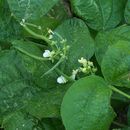en
names in breadcrumbs


Phaseolus (bean, wild bean)[1] is a genus of herbaceous to woody annual and perennial vines in the family Fabaceae containing about 70 plant species, all native to the Americas, primarily Mesoamerica.[2][3]
It is one of the most economically important legume genera. Five of the species have been domesticated since pre-Columbian times for their beans: P. acutifolius (tepary bean), P. coccineus (runner bean), P. dumosus (year bean), P. lunatus (lima bean), and P. vulgaris (common bean).[4][5] Most prominent among these is the common bean, P. vulgaris, which today is cultivated worldwide in tropical, semitropical, and temperate climates.
Phaseolus species are used as food plants by the larvae of some Lepidoptera species, including common swift, garden dart, ghost moth Hypercompe albicornis, H. icasia and the nutmeg.
The generic name Phaseolus was introduced by Linnaeus in 1753,[6] from the Latin phaseolus, a diminutive of phasēlus, in turn borrowed from Greek φάσηλος 'cowpea', of unknown origin.[7][8] The Latin word phaseolus is often incorrectly glossed as 'kidney bean', a New World crop.[7]
Previous classifications placed a number of other well-known legume species in this genus, but they were subsequently reassigned to the genus Vigna, sometimes necessitating a change of species name. For example, older literature refers to the mung bean as Phaseolus aureus, whereas more modern sources classify it as Vigna radiata. Similarly, the snail bean Vigna caracalla was discovered in 1753 and in 1970 moved from Phaseolus to Vigna. The modern understanding of Phaseolus indicates a genus endemic only to the New World.[2]
Species have been organized into eight groups based on phylogenetic clades:[9][10][11]
Leptostachyus group
Lunatus group
Pauciflorus group
Pedicellatus group
Polystachios group
Tuerckheimii group
Vulgaris group
Uncategorized
The Phaseolus plant has an OPALS plant allergy scale rating of 4 out of 10, indicating moderate potential to cause allergic reactions, exacerbated by over-use of the same plant throughout a garden. Leaves can cause skin rash and old plants often carry Rust (fungus).[12]
Phaseolus (bean, wild bean) is a genus of herbaceous to woody annual and perennial vines in the family Fabaceae containing about 70 plant species, all native to the Americas, primarily Mesoamerica.
It is one of the most economically important legume genera. Five of the species have been domesticated since pre-Columbian times for their beans: P. acutifolius (tepary bean), P. coccineus (runner bean), P. dumosus (year bean), P. lunatus (lima bean), and P. vulgaris (common bean). Most prominent among these is the common bean, P. vulgaris, which today is cultivated worldwide in tropical, semitropical, and temperate climates.